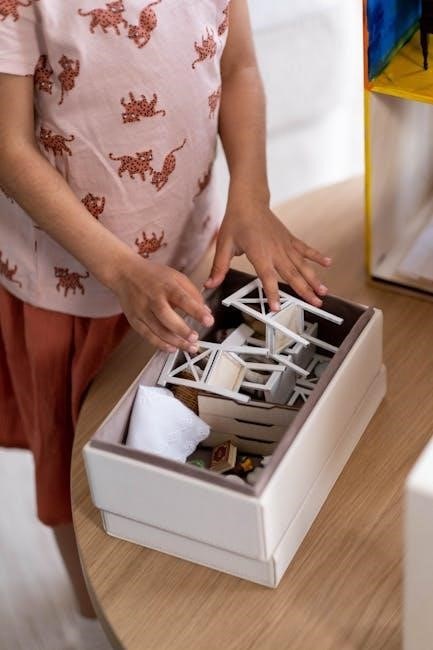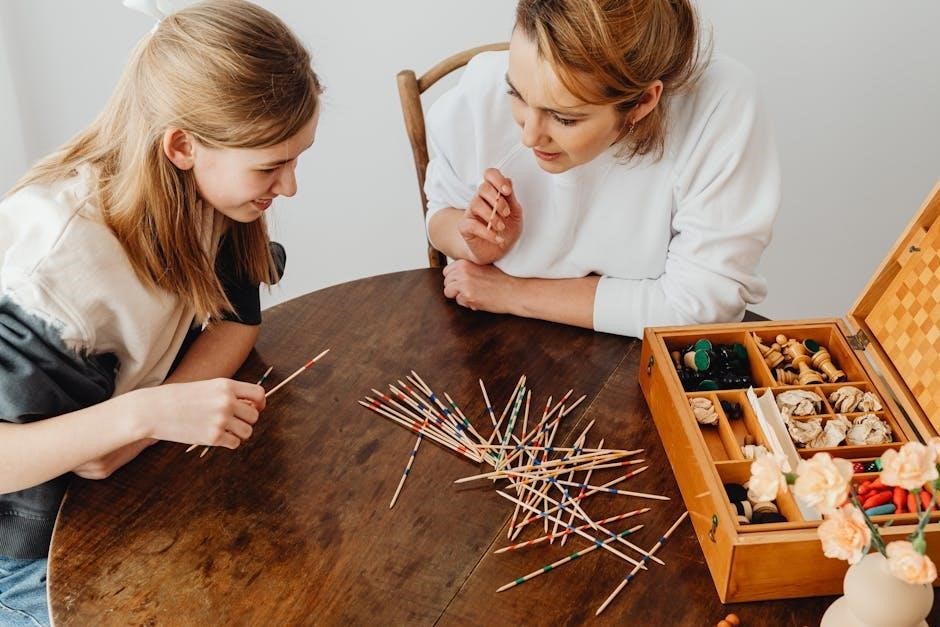
instructions for shut the box game
Shut the Box is a classic dice game where players aim to close numbers on a box by rolling dice, enhancing number recognition and strategic thinking skills.
Overview of the Game
Shut the Box is a classic dice game where players roll dice and close numbers on a box to achieve the lowest score or close all numbers. Played solo or with multiple players, it involves strategic number closing and dice combinations. Suitable for casual or competitive play, the game enhances math skills and strategic thinking while offering fun for all ages.
Objective of the Game
The objective is to close as many numbers as possible on the box by rolling dice and matching their sums. The goal is to shut all numbers or achieve the lowest score. Players aim to strategically cover numbers while minimizing leftovers. The winner is the one who successfully closes all numbers or has the lowest remaining total, showcasing their skill and efficiency in gameplay.

Equipment Needed
The game requires a Shut the Box game box with numbered tiles, a pair of dice, and scorekeeping tools like a scorepad and pen for tracking points.
The Game Box
The game box features numbered tiles or levers, typically ranging from 1 to 9 or 12, which players close by rolling corresponding dice sums. Durable and compact, it’s crafted from wood or plastic, designed for easy portability and repeated use. The box is the centerpiece of the game, allowing players to track progress visually as numbers are closed, making it an essential component for gameplay.
Dice
The game requires one or more standard six-sided dice, typically two, rolled to determine the sum used to close numbers on the box. The dice are essential for generating the random totals needed for gameplay, with their quality and fairness crucial for ensuring unbiased outcomes. They are usually made of plastic or wood, and their condition can significantly impact the gaming experience.
Scorekeeping Tools
A scorepad and pen are essential for tracking players’ progress and calculating final scores. Points are typically tallied based on the numbers remaining open at the end of a round. Accurate scorekeeping ensures fair competition and determines the winner, who usually has the lowest total score. These tools are crucial for maintaining game integrity and facilitating smooth gameplay.

Setup and Preparation
Begin by opening the box, ensuring all numbers are visible. Players roll dice to determine who goes first, with the highest number starting the game.
Opening the Box
The game begins by opening the box, ensuring all number levers are lifted and visible. This setup allows players to start with a clean slate, as all numbers are initially available for closing. Properly opening the box is essential for a fair and enjoyable game, setting the stage for strategic play and competition among participants.
Initial Player Selection
Players determine who goes first by rolling the dice, with the highest number rolled earning the first turn. This method ensures a fair and random start, preventing disputes. Once the initial player is selected, the game proceeds in a clockwise manner, allowing all participants to take turns strategically closing numbers and aiming for the lowest score or a complete shutdown of the box.
Basic Rules and Objectives
Shut the Box is a classic dice game where players roll dice and close numbers on a box, aiming to achieve the lowest score or shut the box completely, enhancing number recognition and strategic thinking skills.
Understanding Number Closing
Number closing involves using dice rolls to shut numbers on the box. Players roll dice, calculate the total, and close numbers that match or add up to the sum. Each number can be closed individually or in combination with others. Once a number is closed, it remains shut for the rest of the game. The goal is to close as many numbers as possible to achieve the lowest score or win by shutting the entire box.
Scoring Mechanisms
Scoring is based on the numbers remaining open at the end of a player’s turn. Each open number is added to calculate the total score. The player with the lowest score wins. If all numbers are closed, the player achieves a perfect “shut the box” and automatically wins. A scorepad is used to track totals, ensuring clear and fair gameplay for all participants involved.

Gameplay Mechanics
Players roll dice, determine the sum, and close corresponding numbers on the box. Turns alternate among players, with the goal of minimizing remaining open numbers strategically.
Starting the Game
To begin, ensure the box is fully opened, revealing all numbers. Players roll the dice to determine who starts, with the highest roll going first. The objective is to close numbers on the box by matching dice sums. Turns alternate, and the player closing the most numbers gains an advantage. The game starts with all numbers visible, ready for strategic closure.
Rolling the Dice
Players roll the dice to determine who starts, with the highest number rolling first. During turns, roll both dice, add the numbers, and use the sum to close numbers on the box. Each number can only be closed once. If no valid numbers match the sum, the turn ends. Strategic rolls are key to closing numbers effectively and progressing toward victory;
Closing Numbers
Closing numbers involves using the dice sum to shut numbers on the box. Players must select numbers that add up to the dice total. Each number can only be closed once. If no valid combination matches the sum, the turn ends. Strategic closing is crucial to minimize remaining numbers and achieve a lower score, enhancing chances of winning the game.

Scoring and Winning
The score is the sum of all open numbers remaining on the box. The player with the lowest score wins. Closing all numbers results in a score of zero, securing an automatic win.
Calculating the Score
The score is calculated by summing all open numbers on the box. The player with the lowest total wins. If all numbers are closed, the score is zero, securing victory. Scores are typically recorded with a scorepad and pen, ensuring clarity in determining the winner.
Determining the Winner
The winner is the player who closes all numbers on the box, achieving a perfect game. If no player shuts the box, the winner is the one with the lowest score. In case of a tie, the player who closed the most numbers is declared the winner. The game can be played individually or with multiple players, following the same rules.

Advanced Strategies
Advanced players optimize dice rolls to close higher numbers first, balancing singles and combinations to minimize remaining numbers, ensuring strategic moves for victory.
Optimizing Dice Rolls
Optimizing dice rolls involves prioritizing higher numbers first, as they are harder to close. Players should balance singles and combinations to maximize number closures. Managing turns strategically ensures versatile dice sums, increasing chances to close remaining numbers efficiently. This approach enhances gameplay and boosts the likelihood of achieving a lower score or even shutting the box entirely.
Minimizing Remaining Numbers
Minimizing remaining numbers requires strategic planning and efficient dice use. Prioritize closing higher numbers first, as they are harder to close later. Balance singles and combinations to maximize closures. Plan ahead to target multiple numbers with each roll, reducing the total remaining. This approach enhances efficiency and increases chances of closing all numbers, achieving the ultimate goal of shutting the box completely.

Variations and House Rules
Shut the Box offers customizable rules, allowing players to adapt gameplay to their preferences. Common variations include betting, team play, or modifying winning conditions for added challenge.
Alternative Gameplay Styles
Shut the Box can be played with various twists, such as team play, timed rounds, or betting on outcomes. Some versions allow for penalty points or bonus rewards, while others introduce unique winning conditions like closing specific number combinations. These styles add diversity and excitement, making the game adaptable to different player preferences and skill levels.
Custom Rules and Modifications
Players can tailor Shut the Box by introducing custom rules, such as time limits for turns or team-based play. Some variations include penalty points for unused numbers or bonus rewards for specific combinations. Modifications like allowing only even or odd numbers to be closed add complexity. These adjustments enhance adaptability, making the game more challenging or dynamic based on player preferences and skill levels.

Common Mistakes to Avoid
Incorrect number closing and mismanagement of turns are common errors. Players must ensure they close valid numbers and adhere to turn sequences to maintain fair gameplay.
Incorrect Number Closing
Incorrect number closing occurs when a player shuts a number that doesn’t match the dice sum. This mistake often results from inattention or poor addition skills. Players must ensure the numbers they close add up exactly to the dice total. Failing to do so can lead to penalties or disqualification. Always double-check the numbers before closing to avoid this common error and maintain fair gameplay.
Mismanagement of Turns
Mismanagement of turns occurs when players fail to follow proper sequence or skip their turn improperly. This can lead to confusion and unfair gameplay. Players must ensure they follow the established order and complete their turn before the next player begins. Incorrectly ending a turn or skipping players can invalidate the game, so attention to turn order is crucial for maintaining fair and enjoyable play.
Learning and Improvement
Regular practice and analyzing gameplay patterns help players enhance their skills. Mastering number recognition and strategic thinking are key to improving performance in Shut the Box.
Practicing the Game
Regular practice helps improve skills. Start with solo sessions to master number closing and dice combination strategies. Focus on minimizing remaining numbers by optimizing rolls. Track progress and analyze errors to refine techniques. Engage in multiplayer practice to adapt to competitive dynamics. Consistent practice enhances number recognition, strategic thinking, and overall performance in Shut the Box;
Analyzing Gameplay Patterns
Analyzing gameplay patterns helps identify successful strategies and areas for improvement. Reviewing past games reveals common dice roll outcomes and number-closing trends. Players can track their progress using scorecards to refine techniques. Understanding these patterns enhances decision-making and minimizes remaining numbers. Experienced players often recognize patterns, adapting their tactics to optimize outcomes and achieve lower scores consistently.
Benefits of Playing
Playing Shut the Box enhances number recognition, improves strategic thinking, and boosts mental agility. It fosters quick decision-making and basic arithmetic skills, making it enjoyable and educational.
Enhancing Number Recognition
Shut the Box improves number recognition by requiring players to quickly identify and close numbers on the box. This enhances mental agility and sharpens the ability to work with numbers. The game encourages rapid identification of number combinations, fostering better understanding of number bonds and sums. It is particularly beneficial for children and adults alike, promoting quick decision-making and arithmetic skills in a fun, interactive way.
Improving Strategic Thinking
Shut the Box fosters strategic thinking by requiring players to plan moves carefully. Each dice roll demands quick decisions to close numbers effectively, encouraging players to anticipate outcomes and adapt strategies. The game sharpens problem-solving skills, as players must prioritize which numbers to close to minimize remaining options. This mental exercise enhances critical thinking and tactical planning in a dynamic, interactive environment.

History and Cultural Significance
Shut the Box is a classic pub game with origins tracing back centuries, traditionally enjoyed in social settings and often associated with gambling in its early forms.
Origins of the Game
Shut the Box traces its origins to traditional European pub games, with roots dating back centuries. It evolved as a popular pastime in social settings, often linked to gambling in its early forms. The game’s simplicity and strategic elements made it a favorite among diverse groups, adapting over time while retaining its core mechanics and charm.
Popularity in Different Regions
Shut the Box is popular in various regions, particularly in UK pubs, where it’s a beloved pastime. In the US, it’s enjoyed in both competitive and casual settings, while in Australia, it’s often played in social clubs. Its appeal lies in its simplicity and ability to enhance number recognition, making it a favorite in educational environments and casual gatherings worldwide.
Tips for Beginners
Start by practicing number recognition and basic strategies. Focus on closing lower numbers first and understanding dice combinations to maximize your chances of winning early.
Mastering Basic Techniques
Begin by understanding how to close numbers effectively. Start with lower numbers, as they are easier to cover with dice rolls. Practice recognizing sums and combinations quickly. Focus on covering numbers that add up to common dice totals, like 7 or 11. Regular practice helps improve your ability to think strategically and make optimal moves during the game.
Understanding Game Dynamics
Shut the Box combines luck and strategy, as dice rolls determine possible moves, but players must decide which numbers to close. The game dynamics involve balancing immediate closures with long-term planning to minimize remaining numbers. Understanding how dice sums interact with available numbers is key to optimizing your gameplay and outperforming opponents effectively.

Hosting a Game
Hosting a Shut the Box game involves organizing players, explaining rules, and ensuring a fair environment. Group players, set up the box, and clarify scoring for a fun, competitive experience.
Organizing Players
To organize players, gather 2-4 participants, as the game is most enjoyable with smaller groups. Determine the starting player by rolling dice, with the highest number going first. Players can compete individually or in teams, splitting into pairs for balanced play. Arrange everyone around the game box, ensuring a fair and structured environment for turns and scoring.
Creating a Competitive Environment
To foster competition, consider setting stakes or a betting pool for winners. Time limits can be introduced for turns, adding pressure and excitement. Encourage players to aim for the lowest score, and recognize top performers publicly. This creates a lively, challenging atmosphere, motivating players to strategize and improve their skills with each round.
Shut the Box is a timeless, engaging game that combines luck and strategy, offering fun for players of all ages. Its simplicity makes it accessible, while its depth enhances cognitive skills like number recognition and strategic thinking. Whether played solo or with friends, it fosters healthy competition and entertainment. Keep practicing to master the game and enjoy the thrill of shutting the box!